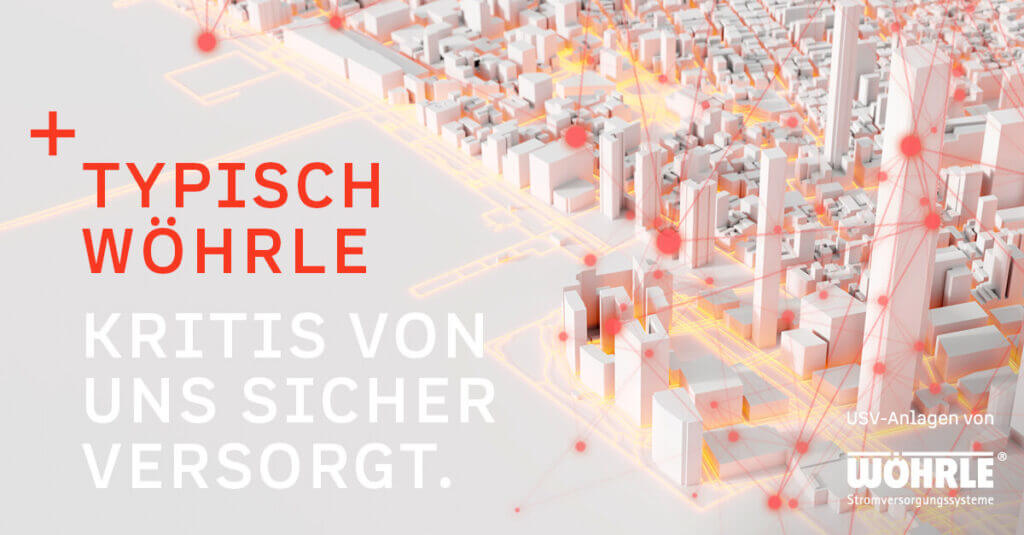KRITIS securely supplied by us

Today, our modern society is more dependent on technical systems than ever before. Without electricity, industrial production would no longer be conceivable and without functioning information and communication technology, no transactions would be possible. Almost every area of our daily lives is supported by digital infrastructures. All these technical systems and facilities in turn require certain basic services in order to function properly. Our buildings need a reliable supply of energy and water, and without transportation, goods and services can neither be produced nor sold. These basic services, which are so important for our society, are referred to as critical infrastructures (KRITIS).
A highly available, expandable, energy-efficient and uninterruptible power supply - UPS - is essential for the safe and reliable operation of critical infrastructures and system-relevant industries.
Definitions of terms
One Uninterruptible power supply - UPS - consists of a combination of electronic power converters and energy storage devices (accumulators) that ensure the short-term maintenance of a consumer's power supply in the event of a supply interruption. Depending on the technology used, the permanent provision of energy is associated with varying degrees of energy loss.
Modularity (also known as the building block principle) is the division of a whole into parts, which are referred to as modules, components or building blocks and interact via corresponding interfaces. In a modularized structure, complete systems are assembled from standardized individual components along defined interfaces. In addition, modular systems offer increased flexibility (adaptability) if various compatible modules are available that can be attached, removed, changed or grouped differently in order to adapt the system to new conditions. A modular UPS system is a parallel-connectable UPS system in which several identical modules (or parallel-connectable individual blocks) interact with each other via defined interfaces.
One Rack-mounted modular UPS system consists of smaller, easily transportable and parallel-connectable UPS modules that are integrated into a system cabinet and interact with each other via defined interfaces.
Redundancy (lat. redundare = to have in abundance). Redundancy is achieved by installing one more module (or system) than is required for the load. Modularity simplifies expansion (scalability).
Scalability avoids costly oversizing and saves energy.
Systemic relevance, companies, critical infrastructures or professions that play such an important economic or infrastructural role in a country that their insolvency or systemic risks cannot be tolerated or their services must be specially protected.
Critical infrastructures
In Germany, organizations and facilities from these sectors are classified as critical infrastructures:
- Energy
Electricity, mineral oil, gas - Health
Medical care, medicines and vaccines, laboratories - State and administration
Government and administration, parliament, judicial institutions, emergency/rescue services including civil protection - Nutrition
Food industry, food trade - Transportation and traffic
Aviation, maritime shipping, inland shipping, rail transport, road transport, logistics - Finance and insurance
Banks, stock exchanges, insurance companies, financial service providers - Information technology and telecommunications
- Media and culture
Broadcasting (television and radio), printed and electronic press, cultural assets, symbolic buildings - Water
Public water supply, public sewage disposal
The operators of these critical infrastructures, regardless of whether they are organized under private or public law, provide the critical services that are essential for supplying the population with high quality and stability.

Checklist
This checklist in brief for specialist planners, installers and operators serves as support for the creation of specifications for UPS systems and their integration in tenders. The conversion losses in UPS systems are cost-intensive to varying degrees due to high and rising electricity costs. Therefore, information on promised efficiencies should be carefully checked and compared.
- Information on efficiencies must be based on measurements of the active power in kW (EN62040-3, 6.6.11 - by measuring the input and output active power during normal operation and available nominal load). Information on efficiencies must be taken into account particularly in the partial load range with 15...50 % utilization (UPS systems are rarely operated under full load and are usually designed redundantly).
- The UPS system must be designed for operating mode V-F-I (double conversion mode / continuous operation) in accordance with EN 62040-3.
- The projected initial rated power and final power must be determined. The data center (server room or technical room) is often started with a low output. The projected final output is usually only achieved years after commissioning. With a plug-in modular system, a favorable operating point (high efficiency) can be guaranteed by adapting to the consumer output without having to change the installation or switch off systems that are already in operation.
- IT load is leading, therefore capacitive. Transformers and motors are usually lagging, i.e. inductive. It must therefore be ensured that the full power in kW is available in the range 0.7 leading to 0.7 lagging without any reduction in power.
- In order to meet the requirements of the highest availability classes (EN 50600, BSI, TIER), it must be possible to maintain or replace UPS modules during operation without switching to the electronic bypass switches (bypass). Switching to the "unprotected mains" is not permitted for higher availability classes and must not be carried out.
- Source: Federal Ministry for the Environment, Nature Conservation and Nuclear Safety, Federal Network Agency, kritis.bund.de